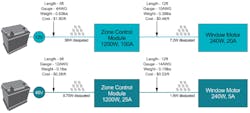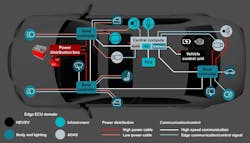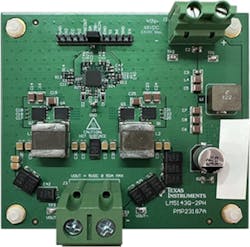Members can download this article in PDF format.
For more than half a century, 48-V low-voltage battery systems have served various segments of the transportation industry, including trucks, buses, agricultural vehicles, boats, aircraft, military, and more. The move to 48-V systems continues to escalate these days because the long-standing, 12-V automotive electrical platform is being pushed to its limits by the orders of magnitude higher power demands of electric and hybrid vehicles.
And not just the drivetrain. The added load of sophisticated, high-power infotainment systems, driver assistance and self-driving computers, sophisticated climate controls, and more are driving (no pun intended) power demands through the roof.
Sponsored Resources
- 48V Automotive Systems: Why now?
- Key benefits of 48V systems in vehicles
- 24-VIN to 60-VIN, 300-W automotive two-phase converter
We all know that, according to Ohm’s law, power and current are related. All things being equal, the lower the potential voltage, the higher the current (P=VI). In Figure 1, two networks with different source voltages are compared. The figure is self-explanatory, and the result is that lower currents mean smaller and lighter wires can be used. This translates into significant savings, not just in cost, but also space and weight.
However, there are other significant advantages besides heat, footprint, and cost. Lowering current reduces EMC and creepage, allows for higher switching frequencies, improves transient load response, and minimizes clearance requirements for wire runs.
As in most cases, a single advancement or platform shift rarely provides optimal results. While replacing 12-V wires with smaller 48-V wires is the biggest step, it doesn’t fully optimize the battery system. So, let’s unpack the 48-V power segment and see what unfolds.
View from the Top
A top-down view of the EV segment finds several iterations of the electric vehicle: mild hybrid-electric vehicles (MHEVs), battery electric vehicles (BEVs), fully hybrid vehicles (HEVs), and plug-in hybrids (PHEVs). While all can use the 48-V platform, there are some idiosyncrasies.
Both MHEVs and some HEVs still use 12-V batteries as well as 48 V. Full hybrids, PHEVs, and BEVs can use a single 48-V platform to supply 12 V. I use the word “can” because some of these still incorporate a 12-V battery for one reason or another. And don't forget that modern EVs also need 25, 16, 5, and 3.3 V.
Zonal Tech and its Benefits
The wiring isn’t the only design undergoing change. 48-V systems are shifting from the typical function-based structure of wiring and CPU/MCU control to a “zone” architecture (Fig. 2). This approach arranges power distribution based on communication and load actuation relative to physical locations. It optimizes wire design, size, and length, and makes new digital hardware easier to design and integrate.
Such an architecture replaces mechanical sensors, activators, and fuses with semiconductor-based devices. Now, wiring networks have become communication networks.
Turning Dumb into Smart
While the upgrade to digital versions of relays, sensors, and fuses is a discussion unto itself, space is limited here, so fuses will be used as an example.
Of course, smart fuses maintain the primary function of opening the circuit. But now, being digital, they can be programmed with functions such as providing real-time component and circuit feedback as well as the condition of the electrical system.
Smart fuses eliminate imprecise tripping, unreliability, and other sloppy characteristics of melting fuses. This is of significant value in monitoring vehicle systems and notification of potential issues before they arise.
They also play a role in energy management. One example is when an EV nears the end of its battery capacity and no immediate charging is available. As part of the communications network, smart fuses can trigger an alert and tell the central controller to turn off power to less critical features, such as seat or window heaters.
Smart fuses also add to the already reduced wiring network. With standard fuses in 12-V systems, wires had to be designed up to 30% larger in diameter beyond load requirements. With smart fuses, wires can be specified to the actual load requirements—there’s no need for additional headroom. That often means a reduction of one wire gauge, sometimes more, which adds further savings in wire weight, space, and cost. For EVs, every little bit helps.
Not Quite All 48 V… Yet
Some components, such as advanced driver-assistance systems (ADAS), infotainment, and cluster applications, still require a 12-V supply, and likely will for some time. The answer to that is a 48- to 12-V converter.
However, dropping in any old converter won’t work. This requires a converter specifically designed for automotive applications. Automotive conditions are extreme, and components must be able to operate at these extremes in many cases.
For that, TI has a developed a reference design specifically for automotive applications—the TI PMP23404 (Fig. 3).
Converters for these applications must be able to deliver high power while minimizing footprint and maximizing efficiency. Power taken for any additional power module is power lost to range.
Therefore, size, weight, and location matter and must be considered as design constraints. Dual phase is desired to keep connectivity as simple as possible. Modules should be as compact as components and thermal considerations allow, especially those slated to be mounted close to the point of load. Finally, thermal stability is important since locations of such devices can be in contained spaces across the vehicle.
Conclusion
Because battery power is now primary power, all eyes are on efficiency as the main driver of the EV ecosystem. 48-V automotive power is on the verge of exploding and will significantly change the EV’s electrical infrastructure.
The transition is gaining momentum at every turn. Many of the challenges that confronted early EV design are being tamed, but many also remain. The adoption of 48-V systems will impact everything from components to systems. A new day is dawning for the EV, and it promises to change vehicles significantly.
Sponsored Resources
- 48V Automotive Systems: Why now?
- Key benefits of 48V systems in vehicles
- 24-VIN to 60-VIN, 300-W automotive two-phase converter



